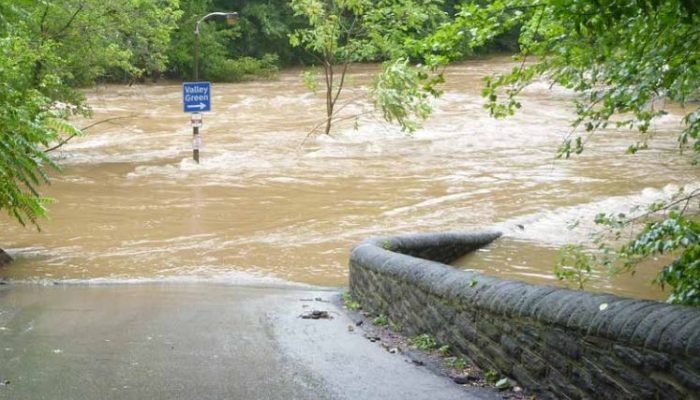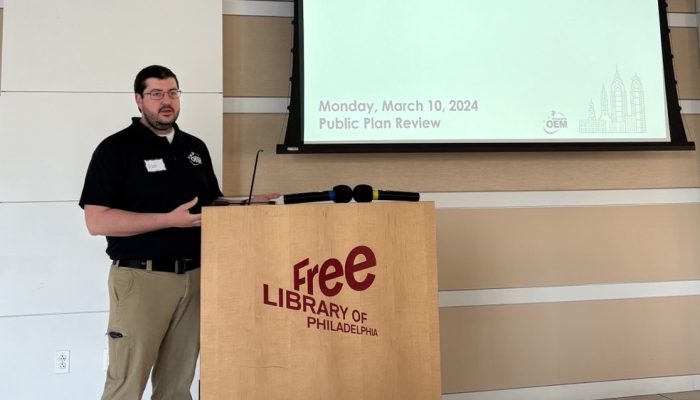Part of the Plan is the Office of Emergency Management’s monthly video series where we open our public safety plans and partnerships. Something we value at OEM is informing and including the public as to your roles in our plans. You are the Public in Public Safety. This month, we talk to the City of Philadelphia’s Floodplain Manager, Josh Lippert, about how the city is affected by flooding and ways you can protect your property from costly damage.
August 14, 2018
Headlines from across the United States this year show the danger and damage that is caused by flooding, including loss of life and property.
Flooding can, and does, happen here in Philadelphia, and it’s not just a problem for those that live near rivers and streams.
In fact, Pennsylvania is one of the most flood prone states in the United States.
According to the National Oceanic and Atmospheric Administration (NOAA), flooding was the greatest cause of property loss attributed to natural hazards in Pennsylvania at a cost of $91.6 million per year from 1996 to 2014.
Urban areas, like Philadelphia, are most susceptible. Flooding can occur quicker as more water runoff is created in developed urbanized areas with less green space available. Urbanization increases runoff by 2 to 6 times over what would occur in natural terrain.
This concern for flooding in Philadelphia led to the creation of the Citywide Flood Risk Management Task Force. This allowed collaboration between departments and agencies to address flooding issues while improving strategy for flood management and city planning.
The City of Philadelphia’s Floodplain Manager, Josh Lippert, pointed out that flood damage is costly and is not covered under typical homeowner’s or renter’s insurance. Lippert also spoke to the importance of knowing if you live in a floodplain in the city. If you live in a flood-prone area, consider submitting an Elevation Certificate which may save you money on your flood insurance premiums.
Search your address to see if your property is in a flood prone area.
Types of Flooding in Philadelphia
Flooding happens in a few ways in Philadelphia. Severe storms that bring heavy rainfall can cause river, surface water or groundwater flooding. When combined with high tide, the sewer system can become overwhelmed and create backups that flood basements. Neighborhoods that are in low-lying areas that are near waterways or close to a dam are more prone. Some floods develop slowly, while others, like flash flooding (which can occur even when there is no rain in our area), can develop in minutes without any visible signs of rain.
- Riverine
- Streams and rivers overflow their banks during short, intense rainstorms and/or hurricane-level rainstorms. Because Philadelphia is located at the lower end of major watersheds, we often see the worst of this type of flooding. A cause of flash flooding.
- Areas Most Impacted: Eastwick, Manayunk, East Falls, Delaware Avenue, watershed parks
- Overland or Street Runoff
- Excessive water running over the ground and streets. This flooding can be made worse when sewers can’t handle the volume. Some areas of Philadelphia experience overland flooding due to the absence of sewers. Overland runoff can also lead to flash floods.
- Areas Most Impacted: Chestnut Hill, Roxborough, Andorra, Germantown, Torresdale
- Groundwater
- When the ground becomes saturated, groundwater may seep through the floors and walls of basements.
- Areas Most Impacted: Exists citywide, but groundwater depth varies depending on rainfall and snow melt.
- Basement Backups
- What It Looks Like: Sewer backups occur when combined sewer systems are overwhelmed by extreme precipitation. The underground sewer system becomes overwhelmed and forces water into basements through drains and fixtures like sinks and toilets. High tides on the Delaware River can contribute to basement backups.
- Areas Most Impacted: Germantown, Kensington, Northern Liberties, Center City, South Philadelphia, Port Richmond.
Be Prepared
- Sign up for the City’s free emergency text and email alert system ReadyPhiladelphia. Emergency information direct from the National Weather Service is sent to you.
- Be ready for an emergency. Make a list of what you own, including furniture, clothing, and valuables.
- Make a Family Emergency Plan. Include everyone in your house, even your pets. Write down important names and phone numbers for you and your family in case of an emergency.
- Have a Go Bag ready that you can grab in case you need to leave your home in a hurry.
- Know the difference between shelter-in-place and a shelter being opened up by OEM. During an emergency, you may be asked to stay in your home for safety reasons, which is shelter-in-place. This differs greatly from a shelter. If you should need to evacuate your home, we may open up a warming center, reception center or shelter. You would be notified where the shelter would be located.
- Learn the safest route from your home to high ground in case you have to evacuate. This should be part of your Family Emergency Plan.
- Know Flash Flood terminology
- Flash Flood Watch: A warning that flash flooding might occur due to heavy rain.
- Flash Flood Warning: A warning that flash flooding is expected due to heavy rain.
Reducing Flood Risk
- Our partners at the Philadelphia Water Department want you to know residents can save money on outdoor landscaping and other green projects by signing up for the Rain Check program. Rain Check is a Philadelphia Water Department program that helps residents manage stormwater and beautify their homes by adding the likes of rain barrels, rain gardens, downspout planters and more.
- PWD’s Green City, Clean Waters program helps with flood mitigation by adding green infrastructure to neighborhoods. Green City, Clean Waters helps reduce stormwater pollution currently entering the city’s Combined Sewer System.
- Clogged sewer inlets are water emergencies! Contact the Philadelphia Water Department at 215-685-6300 and let them know the location.
- The Philadelphia Water Department offers a Basement Protection Program, which was created to assist residents who experience basement backups. PWD calls the Basement Protection Program an important first step in their effort to protect our customers’ properties from flooding during intense rain storms. You can call their hotline at 215-685-6300.
Check Flood Levels
- You can see if the waterway near you is in jeopardy and may cause flooding. The U.S. Geological Survey has streamgages placed all over our area (and the U.S) to give real-time info on water levels in streams and rivers. In fact, they just added three more in our area in Manayunk, Eastwick, and downtown near 30th St. These streamgages monitor water levels, and provide vital data used by emergency managers and flood forecasters to help protect lives and property.
Know your flood zone
- The Federal Emergency Management Agency (FEMA) is continuously reviewing and updating flood hazard information. That information is used to develop detailed flood hazard maps reflecting current flood risks. These maps are called Flood Insurance Rate Maps (FIRMs). Philadelphia’s flood hazard maps were most recently updated in 2015. Digital versions showing current flood zones are available at FloodSmart.gov and also at the City Planning Commission, 1515 Arch 13th Floor.
Insurance Check-Up
- Think about getting flood insurance. Floods are expensive. A few inches of water in a 1,000-square foot home could cost more than $10,000 in repairs and replacement of personal possessions.
- Losses due to flooding are not covered under a homeowner’s policy. Flood insurance is offered through the National Flood Insurance Program (NFIP) or ask your insurance company.
- Homes and buildings in high-risk flood areas with federally-backed mortgages must carry flood insurance.
- Anyone in Philadelphia can buy flood insurance. The cost will be influenced in part by your flood zone, as determined by the Federal Emergency Management Agency (FEMA). Your property’s actual flood risk is determined by many other factors, including the elevation of the building, type of building, and more.
Help Your Home
- There are some common flood-prone areas in or around your home. Property owners can take proactive steps to protect damage or loss of property and valuables:
- Pooling near foundation
- Foundation Cracks
- Valuables on floor
- Sewer backup
- Cracked Lateral
- Blocked Storm drain
- Blocked Gutters
- Pooling near windows
An essential way to be prepared is to stay informed. Get emergency alerts from OEM’s ReadyPhiladelphia program sent to your phone or email to keep you informed prior to and during an emergency. Follow us on Twitter. Like us on Facebook.




